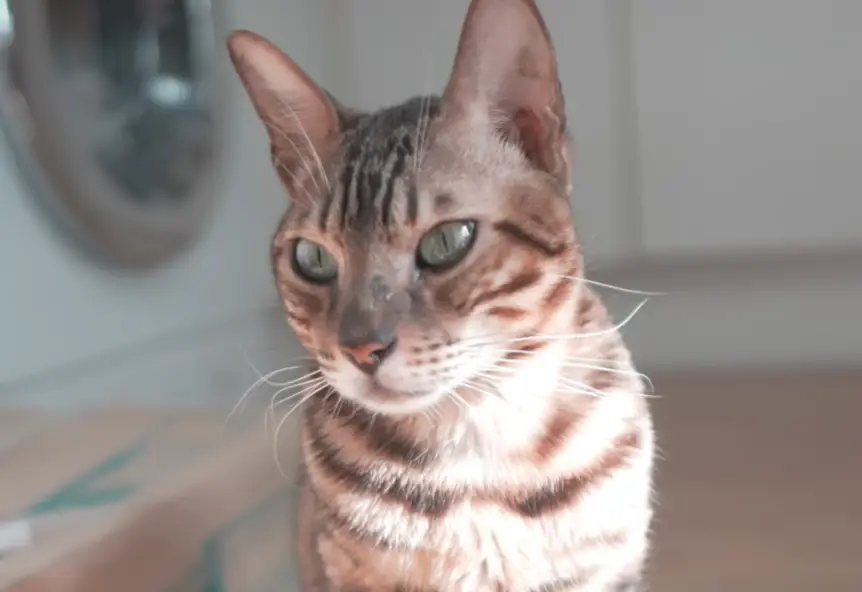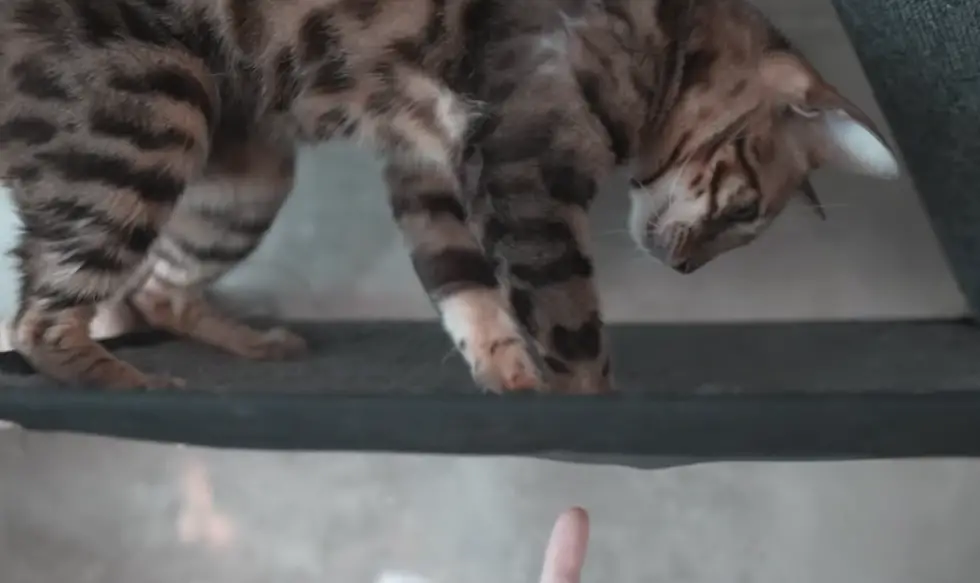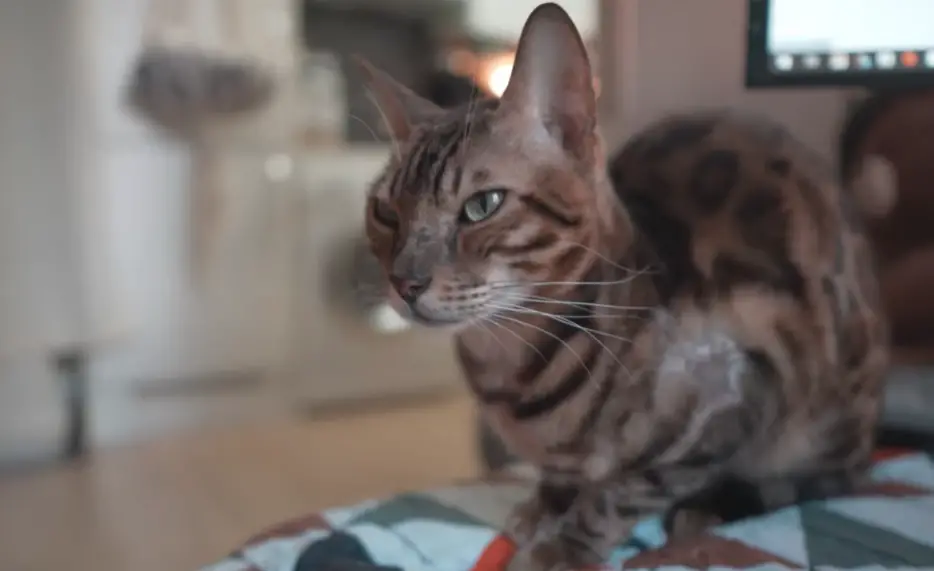Bengal cats are known for their striking looks and wild appearance, but do they come with a side of behavioral problems? Although the Bengal cat is a little bit more unique in terms of character and a lot higher energy, Bengal cats are no more prone to behavioral issues than any other cat breed. They are prone to the same risks as any other cat breed.

Limited research exists on the Bengal cat’s breed and behavior. Still, research is beginning to emerge to assist potential Bengal cat owners in understanding and preparing for this breed.
A study conducted (Behavior and health issues in Bengal cats as perceived by their owners: A descriptive study., Journal of Veterinary Behavior (2020)) in Belgium and the Netherlands surveyed 307 owners of Bengal cats, asking them about their pets’ behaviors and health problems.
Common Bengal Cat Behavioral Problems
The study investigates the behavioral and health issues in the Bengal cat population and how they relate to relinquishment. The study found that the percentage of behaviors considered problematic by the owners was in line with what has been reported in the literature for other breeds.
| Bengal Cat Behavior | Behavior Frequency | Problematic? |
|---|---|---|
| Climbing | 89.5% | No |
| Vocalizing | 88.7% | Yes |
| Playing with water | 79.7% | No |
| Hunting | 78.9% | No |
| Destructive behaviors | 33.2% | Yes |
| Pica | 16.4% | Yes |
| Aggression toward animals | 16% | Yes |
| Inappropriate urination/elimination | 13.3% | Yes |
Key points from the study:
- 61% of Bengal cat owners in the study reported at least one potentially undesirable behavior.
- Vocalization was the most frequently problematic behavior for owners.
- Inappropriate elimination, spraying, and aggression toward people were the most frequently defined as problematic or inconvenient by the respondents.
- Pica (consumption of non-edible materials such as foam, paper, etc.) was the most frequent behavior considered problematic by the respondents, with a prevalence higher than in some studies but lower than in others.
- Destructive behavior was another of the more frequent behaviors considered problematic by half of the owners.
- Only 7 Bengals from the survey had been diagnosed with behavioral problems, and one in ten of the respondents suspected a behavioral problem.
- According to the respondents, most of the cats in the study did not present any health issues.
- The most frequently described problem was overweight, which could be linked to the fact that a high percentage of these cats lived indoors.
Other notable points in the study include the following:
- Very few respondents have become owners of a Bengal cat without searching for information about the breed in advance.
- Character was the most important factor for choosing a Bengal cat, followed by appearance.
Outdoor Bengal Cat VS Indoor Bengal Cat Behavioral Issues
In the study, out of the 256 cats that met the criteria for analysis, 210 cats were reported to be indoor-only, while 46 cats had outdoor access. The study does not report any significant differences in behavior between early and later generations of Bengal cats and between cats with and without outdoor access.

The most frequently defined by respondents as problematic or inconvenient were inappropriate elimination, spraying, and aggression toward people. These behaviors were less frequent than in other studies regarding non-Bengal populations.
The study does not specifically mention any differences in behavior between indoor and outdoor Bengal cats. Still, it does mention that indoor cats are more likely to display “pica” or the eating of non-food items.
However, it’s important to note that cats with access to the outdoors may have more physical and mental stimulation opportunities, which can help keep them active and engaged. See the tips section below on how to do that!
Overall, it’s important for Bengal cat owners to provide their cats with plenty of opportunities for physical and mental stimulation, regardless of whether they have access to the outdoors or not.
Behavioral Differences: Bengal Cat VS Other Cat Breeds
The Bengal cat is often considered active, playful, social, and vocal. Out of all the behaviors displayed by the Bengal cats, vocalization was most frequently problematic to the owners. Other typical behaviors for the breed include climbing, playing with water, and hunting.

While Bengal cats may have unique behaviors, they don’t have any significant behavioral differences compared to other breeds. With proper training and management, any potential behavioral issues can be addressed.
What Are Some Unique Bengal Cat Behaviors?
Bengal cats are considered to be a hybrid breed, as they are a cross between the domestic cat and the wild Asian leopard cat (Prionailurus bengalensis). This wild heritage gives them a unique appearance and a high energy level compared to other domestic cat breeds.
However, it is important to note that organizations such as the International Cat Association have recognized Bengal cats as a domestic cat breed for several generations. Thus, Bengals cats are considered to be a domestic pet and are not considered wilder than other domestic cat breeds.
In general, here are some unique behaviors often observed in Bengal cats:
- Extremely chatty. They are highly vocal and love to voice their opinions.
- Consistently high energy. While most cats’ energy level drops off as they age, Bengal cats tend to have the same energy levels.
- Curiosity with water. Most Bengal cats are interested in water, and some even enjoy showers!
Tips for Bengal Cat Owners
As a new Bengal cat owner, prepare for their high energy level and unique behaviors. Bengal cats are known for their wild and energetic personalities, making them unique and fun to be around.

Here are some tips to help you provide proper stimulation and enrichment for your Bengal cat:
- Provide plenty of climbing opportunities. Bengal cats love to climb and explore high places. Invest in a sturdy cat tree or cat shelves to provide your cat with various heights to climb on. Catification is crucial for Bengal cats!
- Offer interactive toys. Bengal cats are highly active and need plenty of stimulation to keep them entertained. Interactive toys such as puzzle feeders and laser pointers can provide a great way to keep your cat mentally and physically engaged.
- Address common behavioral problems. Bengal cats are known to exhibit aggressive or destructive behavior from time to time. If your cat is displaying such behavior, it’s important to address it early on through the strategies outlined here!
- Rule out medical causes. In some cases, behavioral problems can be caused by underlying medical conditions. Consult with a veterinarian to rule out any potential health issues that may be contributing to your cat’s behavior.
- Consider investing in a cat wheel! The Bengal’s curiosity and boldness make them great candidates for cat wheel training. Check out the complete cat wheel guide here!
- Sometimes a Bengal cat’s boldness can be viewed as aggressive, be sure to know when your cat is overstimulated, afraid, or just simply bored. This article can help.
Bengal Cats: Conclusion
By providing your Bengal cat with the right stimulation and addressing any behavioral problems early on, you can ensure a positive and fulfilling relationship with your furry friend. Remember that Bengal cats are unique and loving and can make great companions. They can be a great addition to any family with proper care and understanding, especially if you’re looking for a dog-like cat breed!
The study suggests that Bengal cats do not have severe behavioral or health problems according to the owners’ perspective, and the owners were generally satisfied with their Bengal cats. It is also important to note that the study did not examine the cats’ welfare, and further research is needed to determine the suitability of Bengal cats as pets from the cats’ own point of view.
